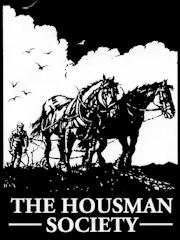A Shropshire Lad
|
|||||||||||||||||||||||||||||||||||||||||||||||||||||||||||||||||||||||||||||||||||||||||||||
Key: V: Textual Variation. C: Commentary. Q: Question. Glossary
ASL XIII “When I was one-and-twenty”
Top ▲ Glossary
| Line | Word | Glossary |
| 3 | crown | A coin worth five shillings, one quarter of a pound in pre-decimal currency. Consider the regal associations |
| 3 | guinea | One pound, one shilling |
| 6 | fancy | Here used as a noun: 1. An impulsive desire for something 2. An unfounded belief about something |
| 14 | rue | Regreted |
Top ▲ Commentary
| Line | Commentary |
| Date: Jan 1895 | |
| 1 | Twenty-one was the “age of majority”; the age at which one was considered truly an adult |
| 2 | The reference to an unspecified “wise man” gives the poem the feel of a moral tale; combined with the strict metre and rhyme, this suggests the folk-song tradition of English popular music |
| 15 | There is a rueful acknowledgement of the actual naivety of many a supposedly mature young person in their early twenties. |
| Whole poem | This is one of a number of poems in the selection which explore the painful nature of emotional experience |
| Metre | Stanzas of alternately rhyming lines of seven then six syllables in an iambic metre: this is a common form in Housman. The two syllable rhyme word in the odd numbered lines has an unstressed final syllable, known as a “feminine” ending |
Top ▲ Questions
| Line | Question |
| 1 | In a letter to Grant Richards (his publisher, from the second edition of ASL onwards), 20 Dec 1920, Housman criticised an illustration of this poem by Claud Lovat Fraser: “How like an artist to think that the speaker is a woman!” Apart from this evidence and the supposed narrator of the collection being ‘Terence Hearsay’, why else might we suppose the speaker to be a man? Also, what does Housman’s comment to Richards tell us about Housman? |
| 1, 7, 8 | Apart from metrical reasons, why do you think Housman writes “one-and-twenty” rather than “twenty-one”? Consider the effect of “two-and twenty” in line 15. |
| 6 | What do you think is meant by “Keep your fancy free”? |
| Whole poem | There is a great deal of repetition in the poem, of words, phrases and in the structure; to what purpose is this put by the poet? |
